Sheridan College Supply Chain Analysis of Toyota Project
VerifiedAdded on 2022/10/12
|12
|1965
|10
Project
AI Summary
This project is a comprehensive supply chain analysis of the Toyota Motor Corporation. It delves into Toyota's competitive strategies, particularly the Toyota Production System, Just-in-Time (JIT) production, and Lean Manufacturing. The analysis examines the company's competitive priorities, order winners, and order qualifiers within the automotive industry. A key component is a detailed exploration of Toyota's supply chain layout, including suppliers, logistics, and transportation methods. The report also identifies and discusses the risks inherent in Toyota's supply chain management, such as those related to the company's reliance on lean manufacturing principles and JIT inventory. The project provides a thorough overview of Toyota's operational efficiency, strategic alignment, and its approach to maintaining a competitive edge in the global automotive market.
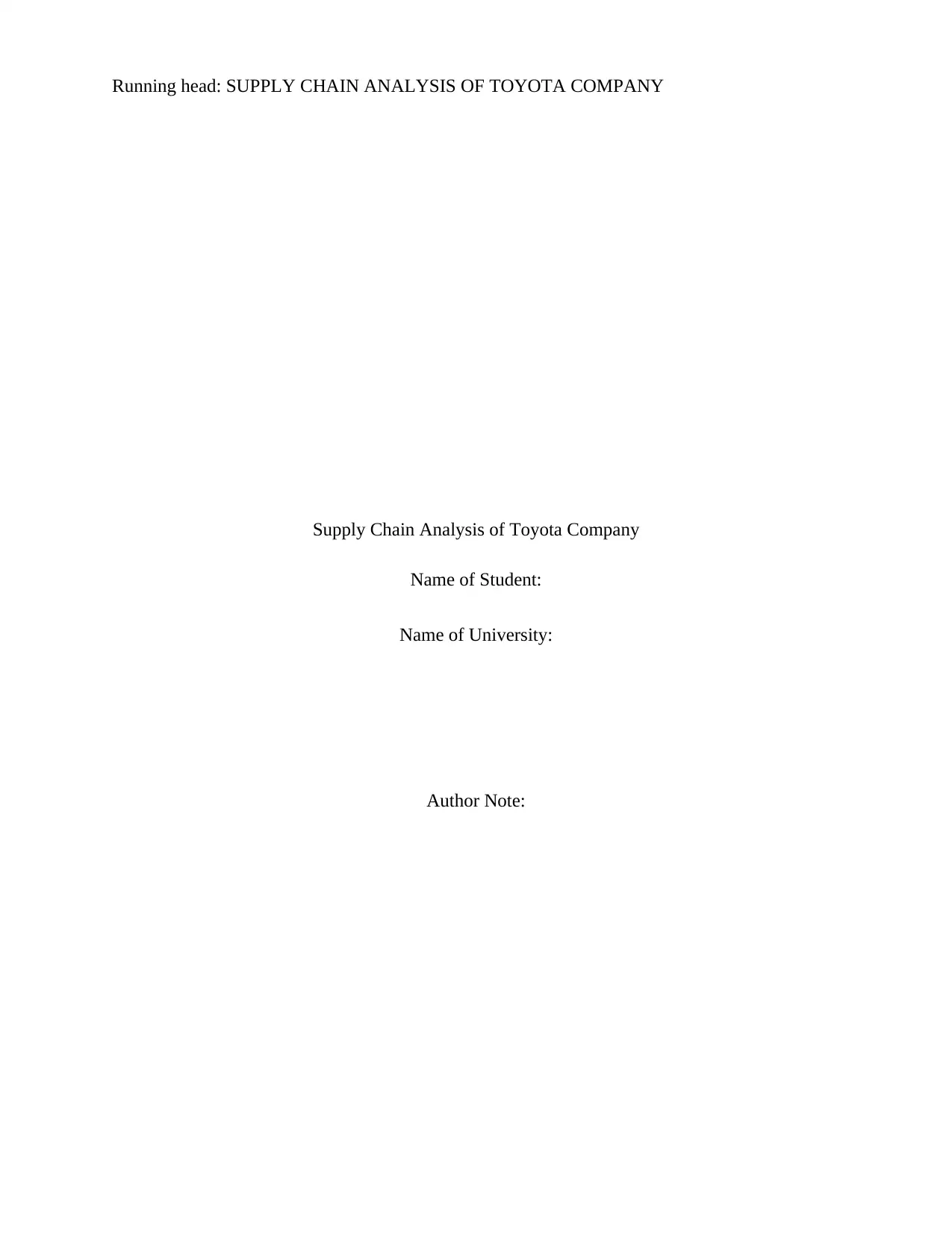
Running head: SUPPLY CHAIN ANALYSIS OF TOYOTA COMPANY
Supply Chain Analysis of Toyota Company
Name of Student:
Name of University:
Author Note:
Supply Chain Analysis of Toyota Company
Name of Student:
Name of University:
Author Note:
Paraphrase This Document
Need a fresh take? Get an instant paraphrase of this document with our AI Paraphraser
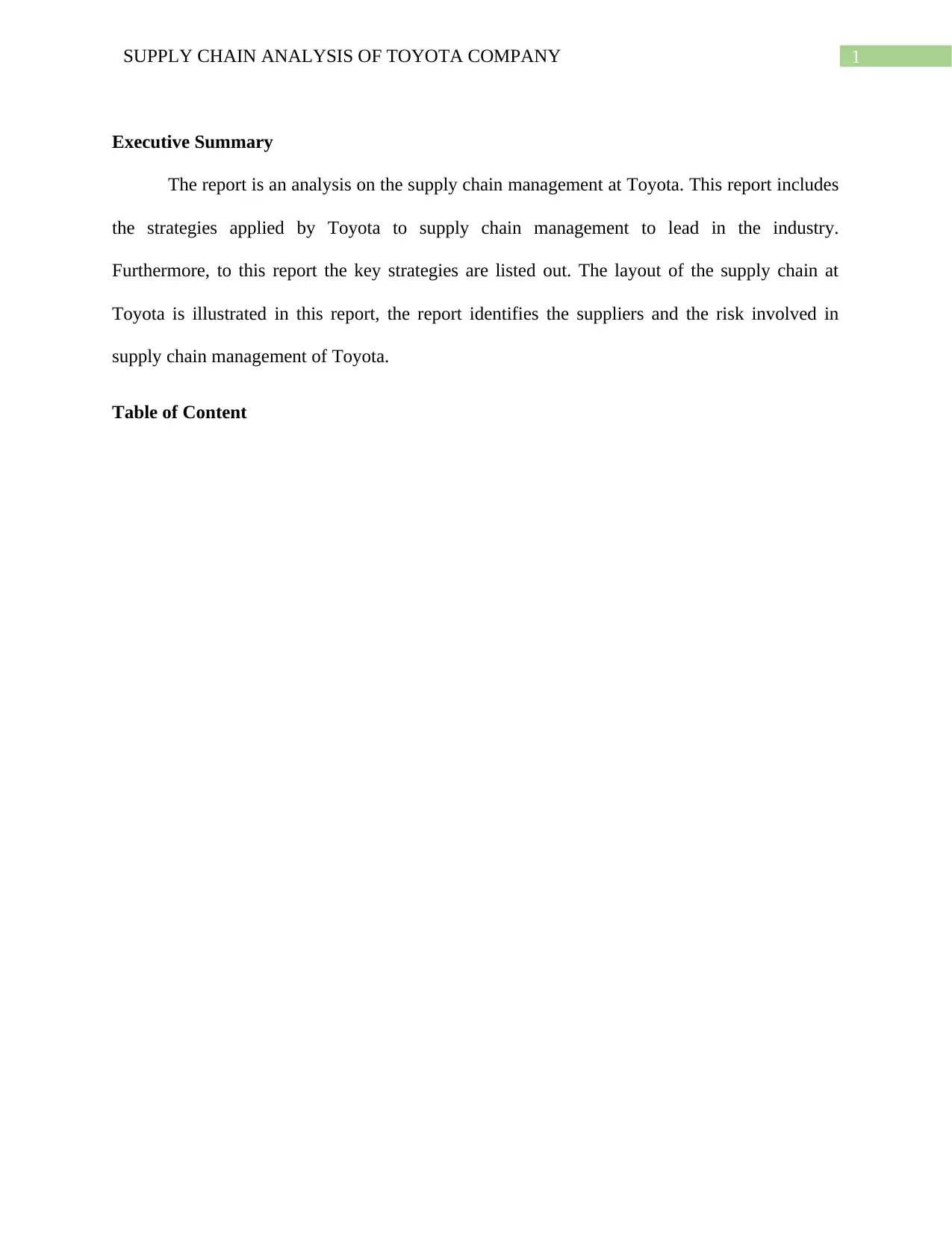
1SUPPLY CHAIN ANALYSIS OF TOYOTA COMPANY
Executive Summary
The report is an analysis on the supply chain management at Toyota. This report includes
the strategies applied by Toyota to supply chain management to lead in the industry.
Furthermore, to this report the key strategies are listed out. The layout of the supply chain at
Toyota is illustrated in this report, the report identifies the suppliers and the risk involved in
supply chain management of Toyota.
Table of Content
Executive Summary
The report is an analysis on the supply chain management at Toyota. This report includes
the strategies applied by Toyota to supply chain management to lead in the industry.
Furthermore, to this report the key strategies are listed out. The layout of the supply chain at
Toyota is illustrated in this report, the report identifies the suppliers and the risk involved in
supply chain management of Toyota.
Table of Content
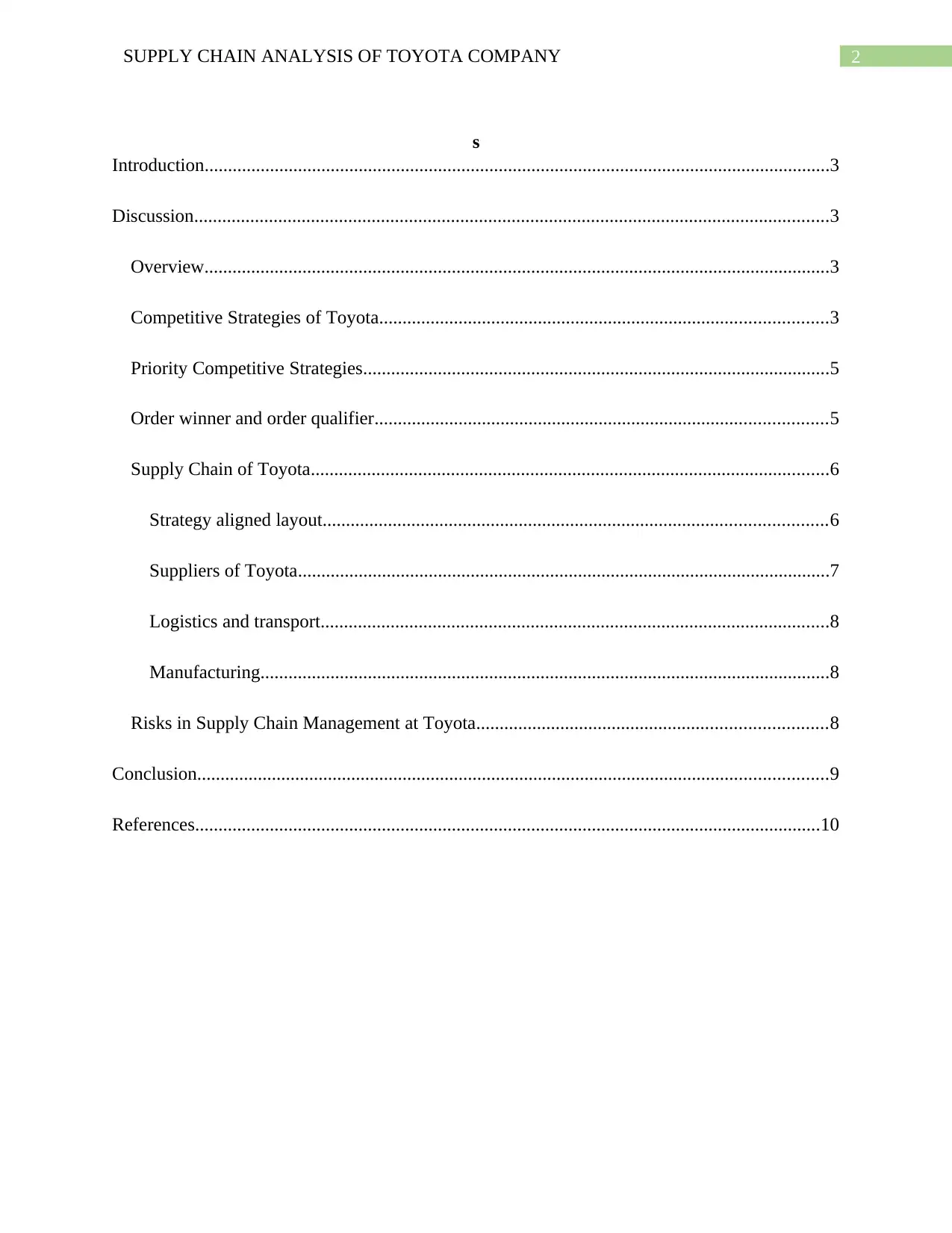
2SUPPLY CHAIN ANALYSIS OF TOYOTA COMPANY
s
Introduction......................................................................................................................................3
Discussion........................................................................................................................................3
Overview......................................................................................................................................3
Competitive Strategies of Toyota................................................................................................3
Priority Competitive Strategies....................................................................................................5
Order winner and order qualifier.................................................................................................5
Supply Chain of Toyota...............................................................................................................6
Strategy aligned layout............................................................................................................6
Suppliers of Toyota..................................................................................................................7
Logistics and transport.............................................................................................................8
Manufacturing..........................................................................................................................8
Risks in Supply Chain Management at Toyota...........................................................................8
Conclusion.......................................................................................................................................9
References......................................................................................................................................10
s
Introduction......................................................................................................................................3
Discussion........................................................................................................................................3
Overview......................................................................................................................................3
Competitive Strategies of Toyota................................................................................................3
Priority Competitive Strategies....................................................................................................5
Order winner and order qualifier.................................................................................................5
Supply Chain of Toyota...............................................................................................................6
Strategy aligned layout............................................................................................................6
Suppliers of Toyota..................................................................................................................7
Logistics and transport.............................................................................................................8
Manufacturing..........................................................................................................................8
Risks in Supply Chain Management at Toyota...........................................................................8
Conclusion.......................................................................................................................................9
References......................................................................................................................................10
⊘ This is a preview!⊘
Do you want full access?
Subscribe today to unlock all pages.

Trusted by 1+ million students worldwide
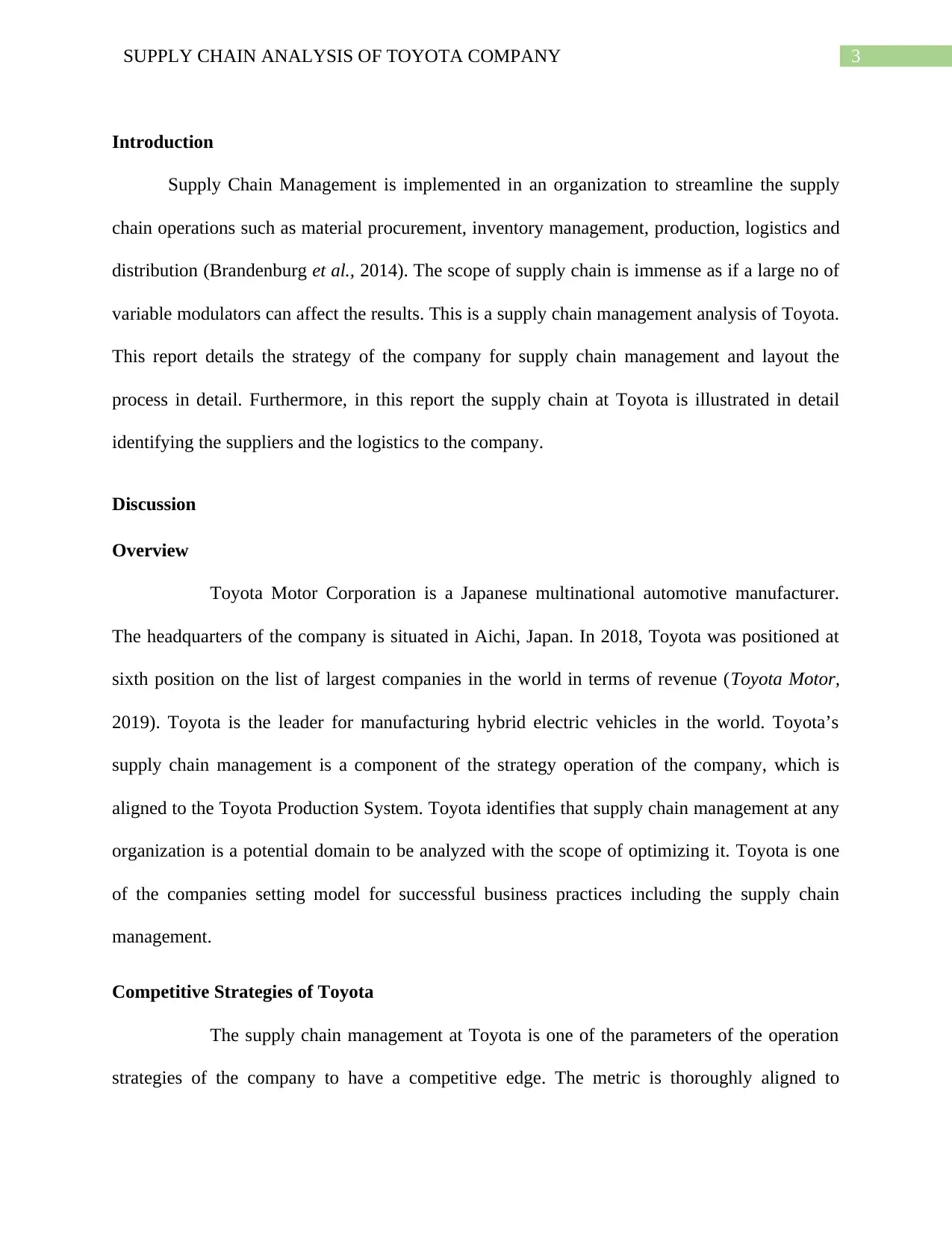
3SUPPLY CHAIN ANALYSIS OF TOYOTA COMPANY
Introduction
Supply Chain Management is implemented in an organization to streamline the supply
chain operations such as material procurement, inventory management, production, logistics and
distribution (Brandenburg et al., 2014). The scope of supply chain is immense as if a large no of
variable modulators can affect the results. This is a supply chain management analysis of Toyota.
This report details the strategy of the company for supply chain management and layout the
process in detail. Furthermore, in this report the supply chain at Toyota is illustrated in detail
identifying the suppliers and the logistics to the company.
Discussion
Overview
Toyota Motor Corporation is a Japanese multinational automotive manufacturer.
The headquarters of the company is situated in Aichi, Japan. In 2018, Toyota was positioned at
sixth position on the list of largest companies in the world in terms of revenue (Toyota Motor,
2019). Toyota is the leader for manufacturing hybrid electric vehicles in the world. Toyota’s
supply chain management is a component of the strategy operation of the company, which is
aligned to the Toyota Production System. Toyota identifies that supply chain management at any
organization is a potential domain to be analyzed with the scope of optimizing it. Toyota is one
of the companies setting model for successful business practices including the supply chain
management.
Competitive Strategies of Toyota
The supply chain management at Toyota is one of the parameters of the operation
strategies of the company to have a competitive edge. The metric is thoroughly aligned to
Introduction
Supply Chain Management is implemented in an organization to streamline the supply
chain operations such as material procurement, inventory management, production, logistics and
distribution (Brandenburg et al., 2014). The scope of supply chain is immense as if a large no of
variable modulators can affect the results. This is a supply chain management analysis of Toyota.
This report details the strategy of the company for supply chain management and layout the
process in detail. Furthermore, in this report the supply chain at Toyota is illustrated in detail
identifying the suppliers and the logistics to the company.
Discussion
Overview
Toyota Motor Corporation is a Japanese multinational automotive manufacturer.
The headquarters of the company is situated in Aichi, Japan. In 2018, Toyota was positioned at
sixth position on the list of largest companies in the world in terms of revenue (Toyota Motor,
2019). Toyota is the leader for manufacturing hybrid electric vehicles in the world. Toyota’s
supply chain management is a component of the strategy operation of the company, which is
aligned to the Toyota Production System. Toyota identifies that supply chain management at any
organization is a potential domain to be analyzed with the scope of optimizing it. Toyota is one
of the companies setting model for successful business practices including the supply chain
management.
Competitive Strategies of Toyota
The supply chain management at Toyota is one of the parameters of the operation
strategies of the company to have a competitive edge. The metric is thoroughly aligned to
Paraphrase This Document
Need a fresh take? Get an instant paraphrase of this document with our AI Paraphraser
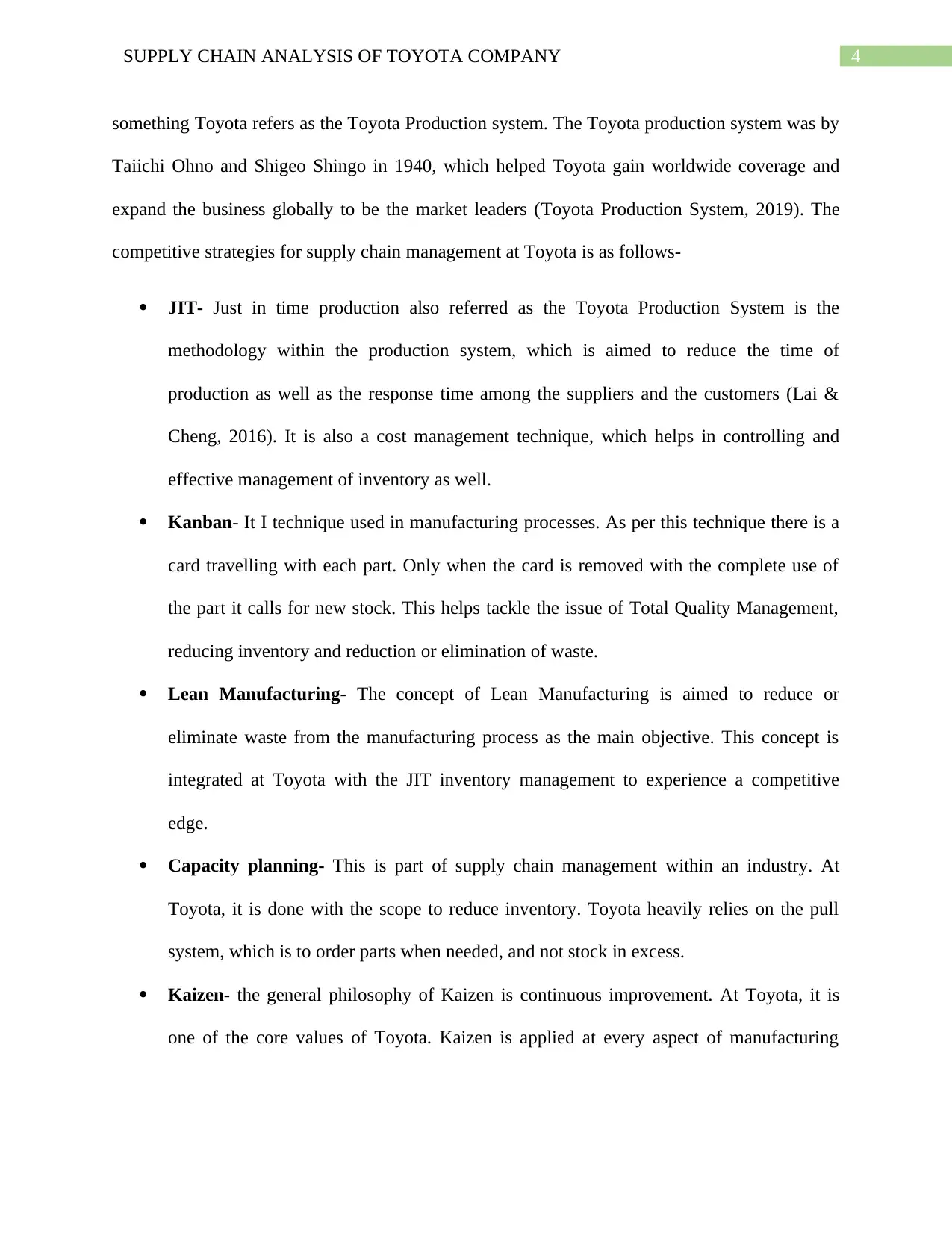
4SUPPLY CHAIN ANALYSIS OF TOYOTA COMPANY
something Toyota refers as the Toyota Production system. The Toyota production system was by
Taiichi Ohno and Shigeo Shingo in 1940, which helped Toyota gain worldwide coverage and
expand the business globally to be the market leaders (Toyota Production System, 2019). The
competitive strategies for supply chain management at Toyota is as follows-
JIT- Just in time production also referred as the Toyota Production System is the
methodology within the production system, which is aimed to reduce the time of
production as well as the response time among the suppliers and the customers (Lai &
Cheng, 2016). It is also a cost management technique, which helps in controlling and
effective management of inventory as well.
Kanban- It I technique used in manufacturing processes. As per this technique there is a
card travelling with each part. Only when the card is removed with the complete use of
the part it calls for new stock. This helps tackle the issue of Total Quality Management,
reducing inventory and reduction or elimination of waste.
Lean Manufacturing- The concept of Lean Manufacturing is aimed to reduce or
eliminate waste from the manufacturing process as the main objective. This concept is
integrated at Toyota with the JIT inventory management to experience a competitive
edge.
Capacity planning- This is part of supply chain management within an industry. At
Toyota, it is done with the scope to reduce inventory. Toyota heavily relies on the pull
system, which is to order parts when needed, and not stock in excess.
Kaizen- the general philosophy of Kaizen is continuous improvement. At Toyota, it is
one of the core values of Toyota. Kaizen is applied at every aspect of manufacturing
something Toyota refers as the Toyota Production system. The Toyota production system was by
Taiichi Ohno and Shigeo Shingo in 1940, which helped Toyota gain worldwide coverage and
expand the business globally to be the market leaders (Toyota Production System, 2019). The
competitive strategies for supply chain management at Toyota is as follows-
JIT- Just in time production also referred as the Toyota Production System is the
methodology within the production system, which is aimed to reduce the time of
production as well as the response time among the suppliers and the customers (Lai &
Cheng, 2016). It is also a cost management technique, which helps in controlling and
effective management of inventory as well.
Kanban- It I technique used in manufacturing processes. As per this technique there is a
card travelling with each part. Only when the card is removed with the complete use of
the part it calls for new stock. This helps tackle the issue of Total Quality Management,
reducing inventory and reduction or elimination of waste.
Lean Manufacturing- The concept of Lean Manufacturing is aimed to reduce or
eliminate waste from the manufacturing process as the main objective. This concept is
integrated at Toyota with the JIT inventory management to experience a competitive
edge.
Capacity planning- This is part of supply chain management within an industry. At
Toyota, it is done with the scope to reduce inventory. Toyota heavily relies on the pull
system, which is to order parts when needed, and not stock in excess.
Kaizen- the general philosophy of Kaizen is continuous improvement. At Toyota, it is
one of the core values of Toyota. Kaizen is applied at every aspect of manufacturing
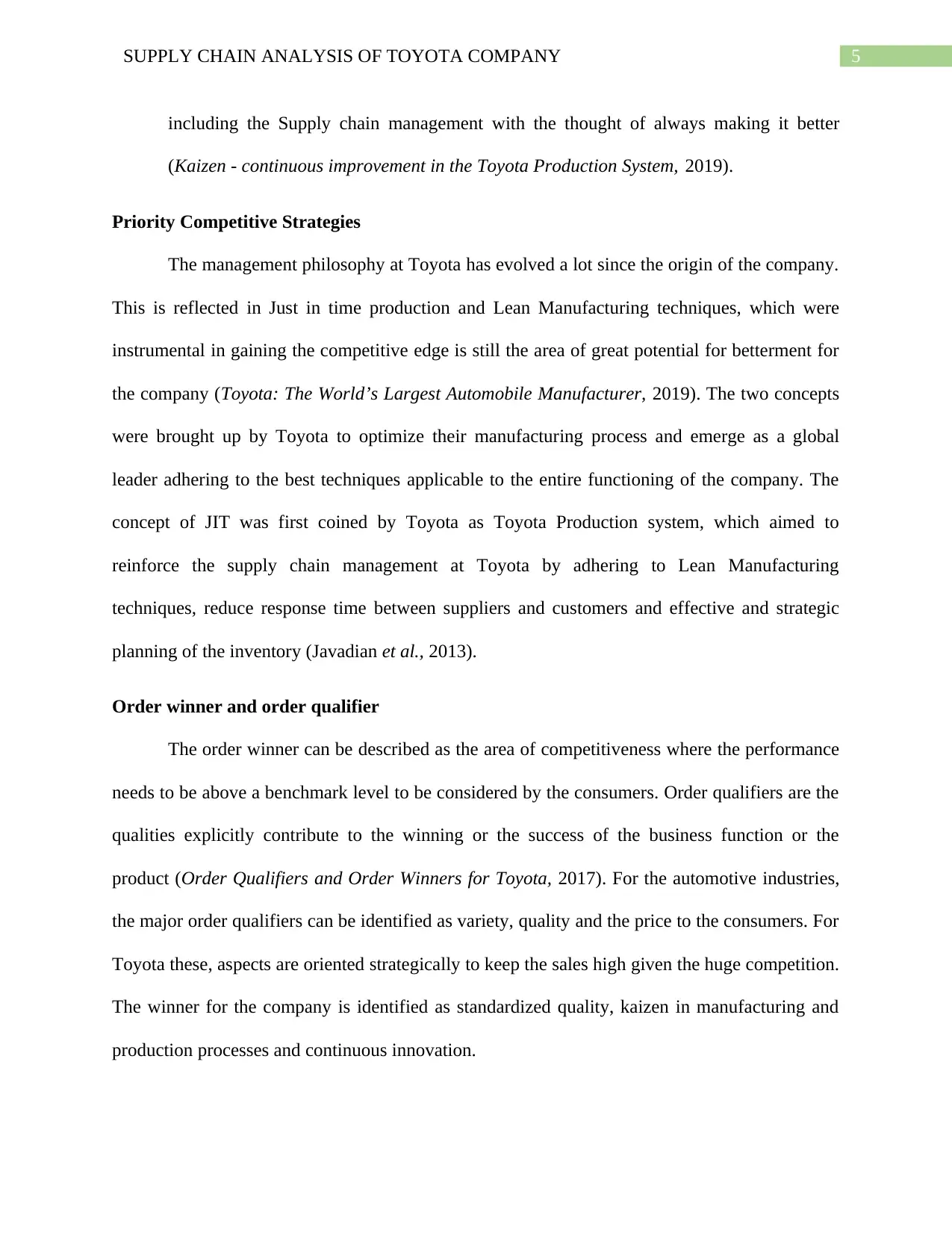
5SUPPLY CHAIN ANALYSIS OF TOYOTA COMPANY
including the Supply chain management with the thought of always making it better
(Kaizen - continuous improvement in the Toyota Production System, 2019).
Priority Competitive Strategies
The management philosophy at Toyota has evolved a lot since the origin of the company.
This is reflected in Just in time production and Lean Manufacturing techniques, which were
instrumental in gaining the competitive edge is still the area of great potential for betterment for
the company (Toyota: The World’s Largest Automobile Manufacturer, 2019). The two concepts
were brought up by Toyota to optimize their manufacturing process and emerge as a global
leader adhering to the best techniques applicable to the entire functioning of the company. The
concept of JIT was first coined by Toyota as Toyota Production system, which aimed to
reinforce the supply chain management at Toyota by adhering to Lean Manufacturing
techniques, reduce response time between suppliers and customers and effective and strategic
planning of the inventory (Javadian et al., 2013).
Order winner and order qualifier
The order winner can be described as the area of competitiveness where the performance
needs to be above a benchmark level to be considered by the consumers. Order qualifiers are the
qualities explicitly contribute to the winning or the success of the business function or the
product (Order Qualifiers and Order Winners for Toyota, 2017). For the automotive industries,
the major order qualifiers can be identified as variety, quality and the price to the consumers. For
Toyota these, aspects are oriented strategically to keep the sales high given the huge competition.
The winner for the company is identified as standardized quality, kaizen in manufacturing and
production processes and continuous innovation.
including the Supply chain management with the thought of always making it better
(Kaizen - continuous improvement in the Toyota Production System, 2019).
Priority Competitive Strategies
The management philosophy at Toyota has evolved a lot since the origin of the company.
This is reflected in Just in time production and Lean Manufacturing techniques, which were
instrumental in gaining the competitive edge is still the area of great potential for betterment for
the company (Toyota: The World’s Largest Automobile Manufacturer, 2019). The two concepts
were brought up by Toyota to optimize their manufacturing process and emerge as a global
leader adhering to the best techniques applicable to the entire functioning of the company. The
concept of JIT was first coined by Toyota as Toyota Production system, which aimed to
reinforce the supply chain management at Toyota by adhering to Lean Manufacturing
techniques, reduce response time between suppliers and customers and effective and strategic
planning of the inventory (Javadian et al., 2013).
Order winner and order qualifier
The order winner can be described as the area of competitiveness where the performance
needs to be above a benchmark level to be considered by the consumers. Order qualifiers are the
qualities explicitly contribute to the winning or the success of the business function or the
product (Order Qualifiers and Order Winners for Toyota, 2017). For the automotive industries,
the major order qualifiers can be identified as variety, quality and the price to the consumers. For
Toyota these, aspects are oriented strategically to keep the sales high given the huge competition.
The winner for the company is identified as standardized quality, kaizen in manufacturing and
production processes and continuous innovation.
⊘ This is a preview!⊘
Do you want full access?
Subscribe today to unlock all pages.

Trusted by 1+ million students worldwide
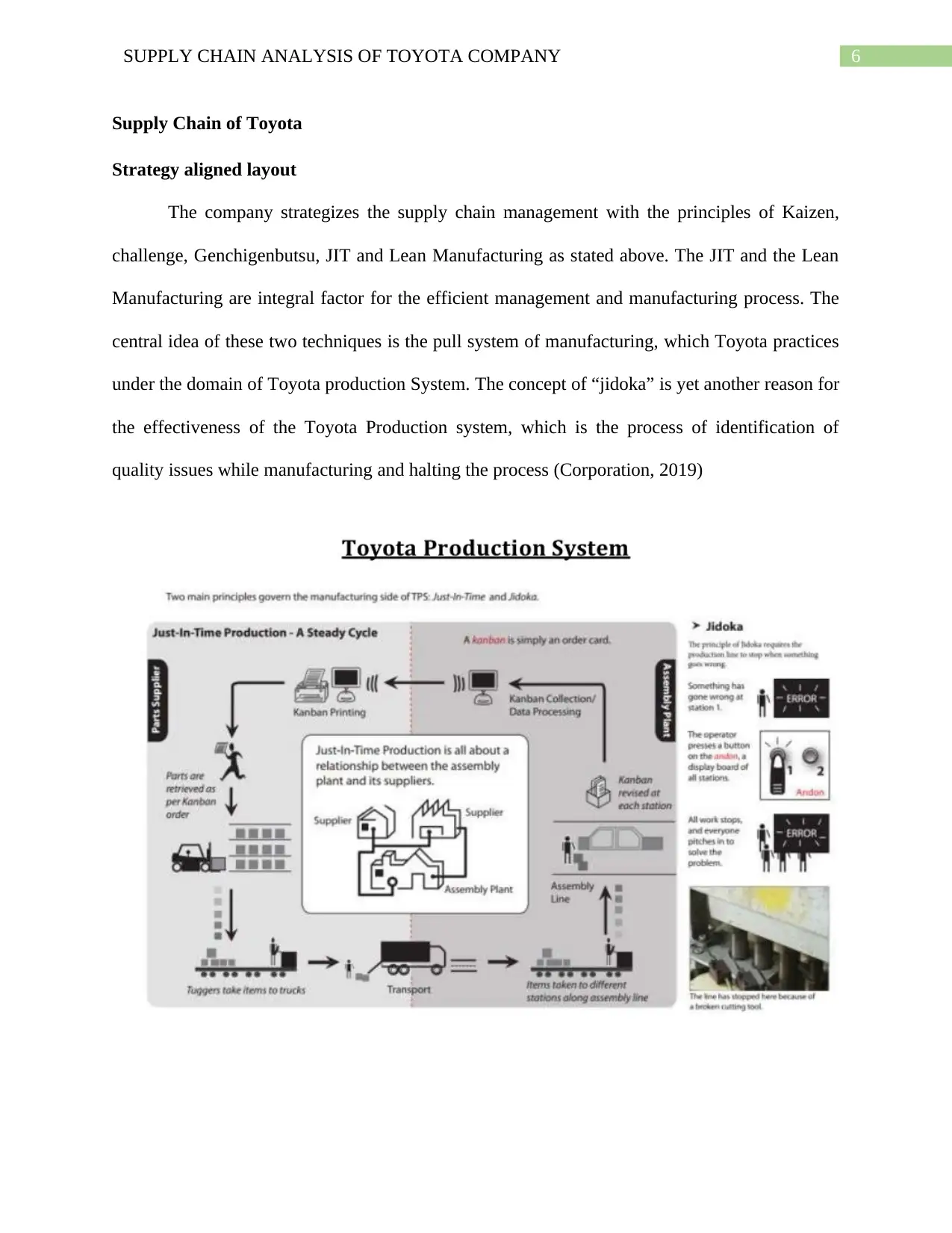
6SUPPLY CHAIN ANALYSIS OF TOYOTA COMPANY
Supply Chain of Toyota
Strategy aligned layout
The company strategizes the supply chain management with the principles of Kaizen,
challenge, Genchigenbutsu, JIT and Lean Manufacturing as stated above. The JIT and the Lean
Manufacturing are integral factor for the efficient management and manufacturing process. The
central idea of these two techniques is the pull system of manufacturing, which Toyota practices
under the domain of Toyota production System. The concept of “jidoka” is yet another reason for
the effectiveness of the Toyota Production system, which is the process of identification of
quality issues while manufacturing and halting the process (Corporation, 2019)
Supply Chain of Toyota
Strategy aligned layout
The company strategizes the supply chain management with the principles of Kaizen,
challenge, Genchigenbutsu, JIT and Lean Manufacturing as stated above. The JIT and the Lean
Manufacturing are integral factor for the efficient management and manufacturing process. The
central idea of these two techniques is the pull system of manufacturing, which Toyota practices
under the domain of Toyota production System. The concept of “jidoka” is yet another reason for
the effectiveness of the Toyota Production system, which is the process of identification of
quality issues while manufacturing and halting the process (Corporation, 2019)
Paraphrase This Document
Need a fresh take? Get an instant paraphrase of this document with our AI Paraphraser
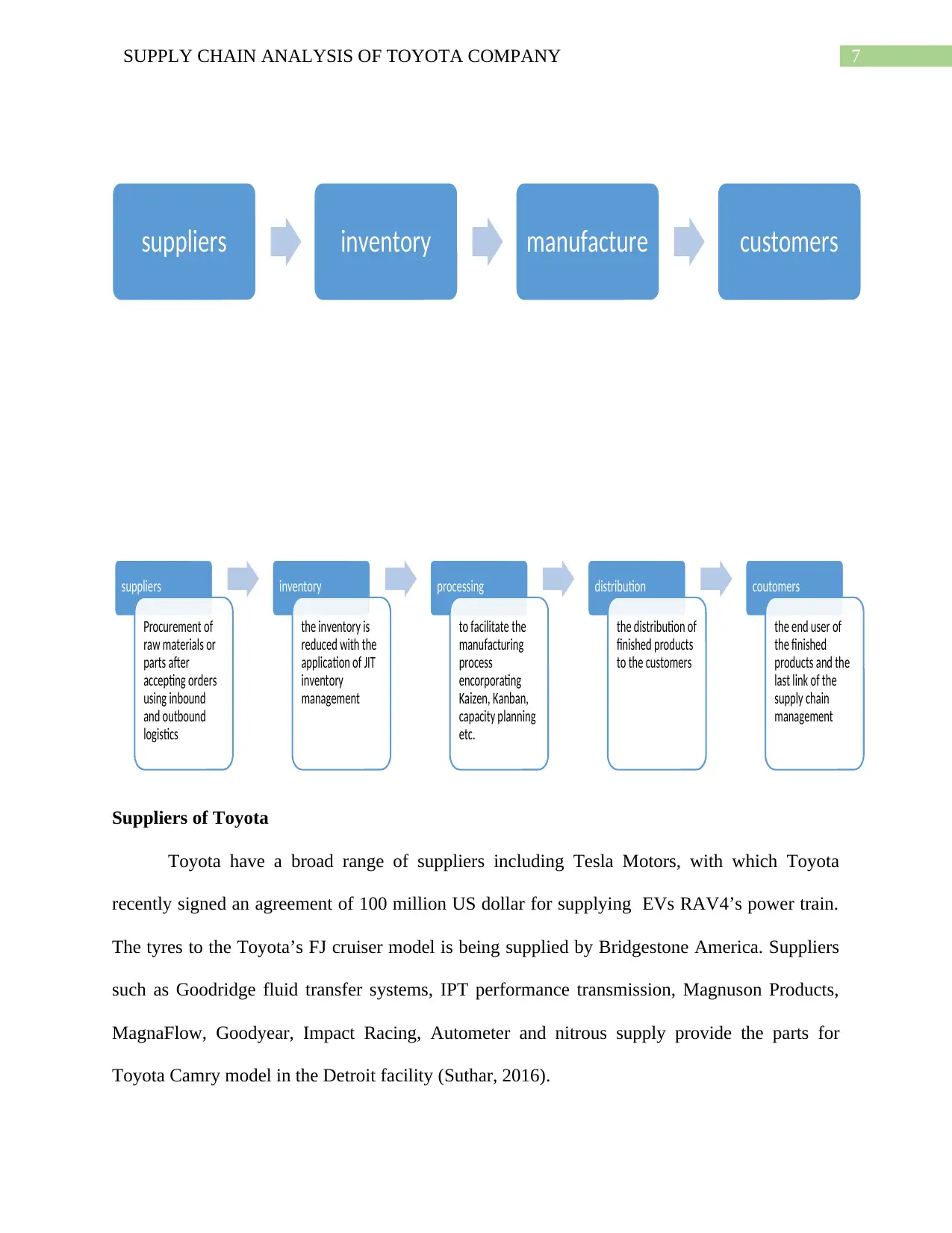
7SUPPLY CHAIN ANALYSIS OF TOYOTA COMPANY
Suppliers of Toyota
Toyota have a broad range of suppliers including Tesla Motors, with which Toyota
recently signed an agreement of 100 million US dollar for supplying EVs RAV4’s power train.
The tyres to the Toyota’s FJ cruiser model is being supplied by Bridgestone America. Suppliers
such as Goodridge fluid transfer systems, IPT performance transmission, Magnuson Products,
MagnaFlow, Goodyear, Impact Racing, Autometer and nitrous supply provide the parts for
Toyota Camry model in the Detroit facility (Suthar, 2016).
suppliers inventory manufacture customers
suppliers
Procurement of
raw materials or
parts after
accepting orders
using inbound
and outbound
logistics
inventory
the inventory is
reduced with the
application of JIT
inventory
management
processing
to facilitate the
manufacturing
process
encorporating
Kaizen, Kanban,
capacity planning
etc.
distribution
the distribution of
finished products
to the customers
coutomers
the end user of
the finished
products and the
last link of the
supply chain
management
Suppliers of Toyota
Toyota have a broad range of suppliers including Tesla Motors, with which Toyota
recently signed an agreement of 100 million US dollar for supplying EVs RAV4’s power train.
The tyres to the Toyota’s FJ cruiser model is being supplied by Bridgestone America. Suppliers
such as Goodridge fluid transfer systems, IPT performance transmission, Magnuson Products,
MagnaFlow, Goodyear, Impact Racing, Autometer and nitrous supply provide the parts for
Toyota Camry model in the Detroit facility (Suthar, 2016).
suppliers inventory manufacture customers
suppliers
Procurement of
raw materials or
parts after
accepting orders
using inbound
and outbound
logistics
inventory
the inventory is
reduced with the
application of JIT
inventory
management
processing
to facilitate the
manufacturing
process
encorporating
Kaizen, Kanban,
capacity planning
etc.
distribution
the distribution of
finished products
to the customers
coutomers
the end user of
the finished
products and the
last link of the
supply chain
management
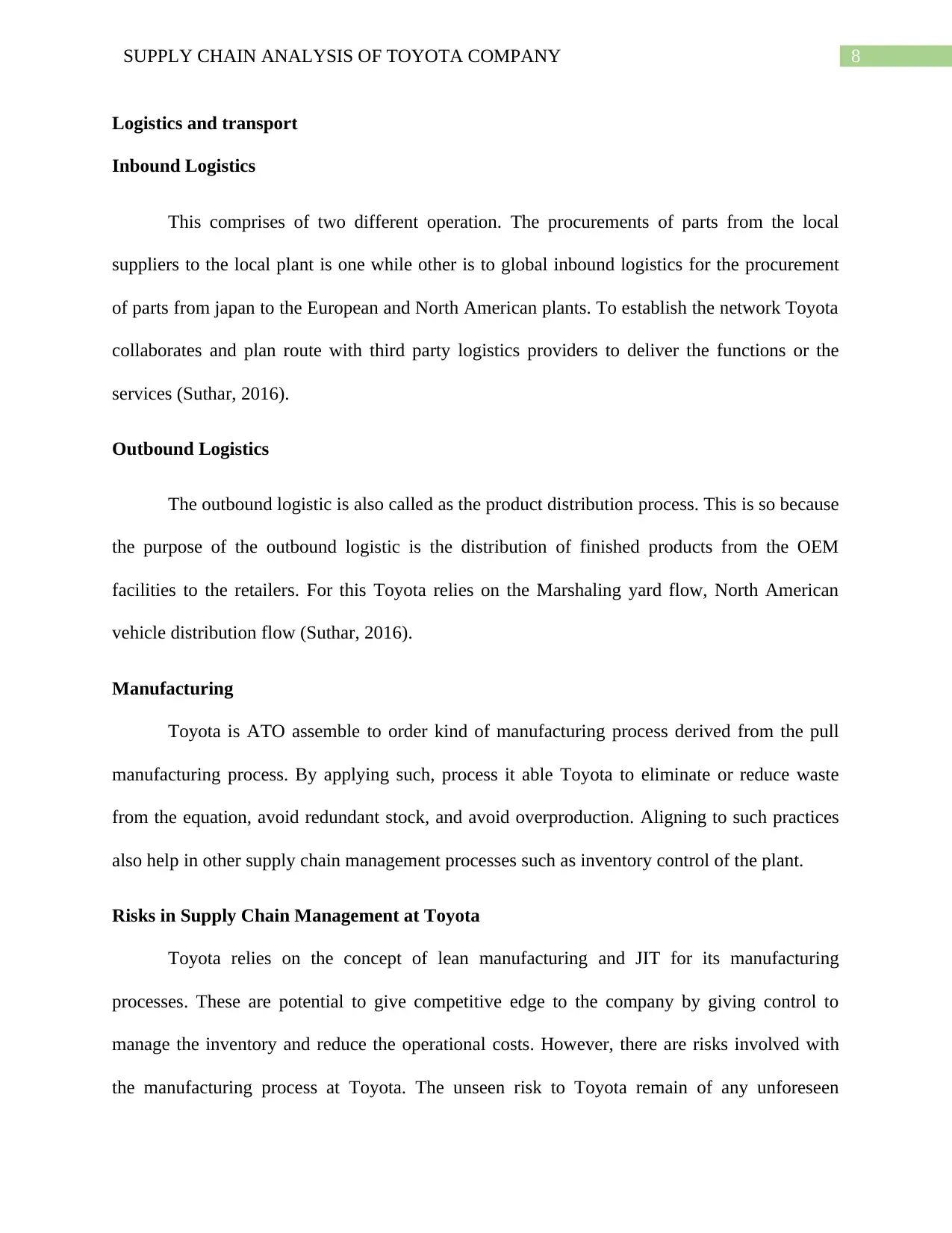
8SUPPLY CHAIN ANALYSIS OF TOYOTA COMPANY
Logistics and transport
Inbound Logistics
This comprises of two different operation. The procurements of parts from the local
suppliers to the local plant is one while other is to global inbound logistics for the procurement
of parts from japan to the European and North American plants. To establish the network Toyota
collaborates and plan route with third party logistics providers to deliver the functions or the
services (Suthar, 2016).
Outbound Logistics
The outbound logistic is also called as the product distribution process. This is so because
the purpose of the outbound logistic is the distribution of finished products from the OEM
facilities to the retailers. For this Toyota relies on the Marshaling yard flow, North American
vehicle distribution flow (Suthar, 2016).
Manufacturing
Toyota is ATO assemble to order kind of manufacturing process derived from the pull
manufacturing process. By applying such, process it able Toyota to eliminate or reduce waste
from the equation, avoid redundant stock, and avoid overproduction. Aligning to such practices
also help in other supply chain management processes such as inventory control of the plant.
Risks in Supply Chain Management at Toyota
Toyota relies on the concept of lean manufacturing and JIT for its manufacturing
processes. These are potential to give competitive edge to the company by giving control to
manage the inventory and reduce the operational costs. However, there are risks involved with
the manufacturing process at Toyota. The unseen risk to Toyota remain of any unforeseen
Logistics and transport
Inbound Logistics
This comprises of two different operation. The procurements of parts from the local
suppliers to the local plant is one while other is to global inbound logistics for the procurement
of parts from japan to the European and North American plants. To establish the network Toyota
collaborates and plan route with third party logistics providers to deliver the functions or the
services (Suthar, 2016).
Outbound Logistics
The outbound logistic is also called as the product distribution process. This is so because
the purpose of the outbound logistic is the distribution of finished products from the OEM
facilities to the retailers. For this Toyota relies on the Marshaling yard flow, North American
vehicle distribution flow (Suthar, 2016).
Manufacturing
Toyota is ATO assemble to order kind of manufacturing process derived from the pull
manufacturing process. By applying such, process it able Toyota to eliminate or reduce waste
from the equation, avoid redundant stock, and avoid overproduction. Aligning to such practices
also help in other supply chain management processes such as inventory control of the plant.
Risks in Supply Chain Management at Toyota
Toyota relies on the concept of lean manufacturing and JIT for its manufacturing
processes. These are potential to give competitive edge to the company by giving control to
manage the inventory and reduce the operational costs. However, there are risks involved with
the manufacturing process at Toyota. The unseen risk to Toyota remain of any unforeseen
⊘ This is a preview!⊘
Do you want full access?
Subscribe today to unlock all pages.

Trusted by 1+ million students worldwide
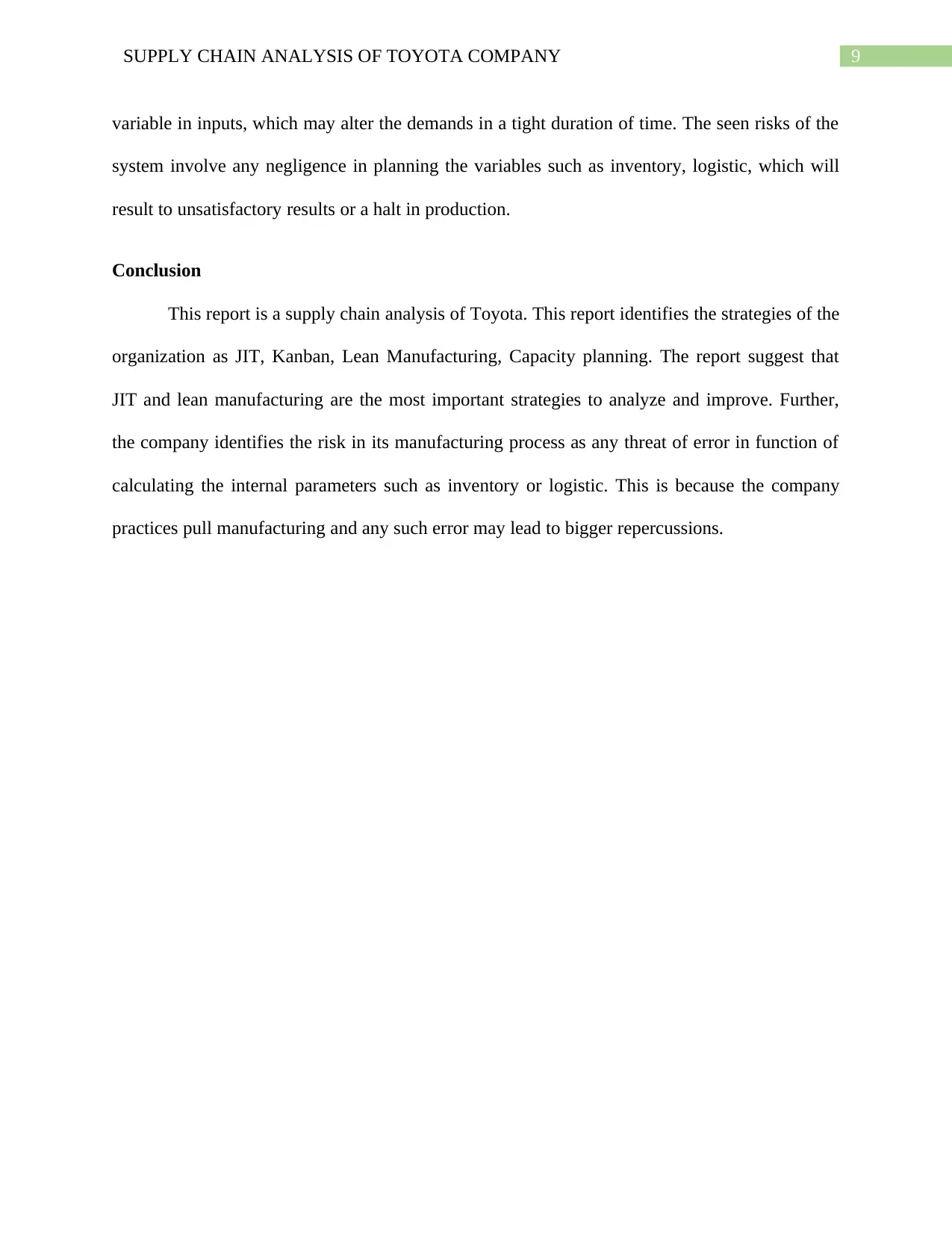
9SUPPLY CHAIN ANALYSIS OF TOYOTA COMPANY
variable in inputs, which may alter the demands in a tight duration of time. The seen risks of the
system involve any negligence in planning the variables such as inventory, logistic, which will
result to unsatisfactory results or a halt in production.
Conclusion
This report is a supply chain analysis of Toyota. This report identifies the strategies of the
organization as JIT, Kanban, Lean Manufacturing, Capacity planning. The report suggest that
JIT and lean manufacturing are the most important strategies to analyze and improve. Further,
the company identifies the risk in its manufacturing process as any threat of error in function of
calculating the internal parameters such as inventory or logistic. This is because the company
practices pull manufacturing and any such error may lead to bigger repercussions.
variable in inputs, which may alter the demands in a tight duration of time. The seen risks of the
system involve any negligence in planning the variables such as inventory, logistic, which will
result to unsatisfactory results or a halt in production.
Conclusion
This report is a supply chain analysis of Toyota. This report identifies the strategies of the
organization as JIT, Kanban, Lean Manufacturing, Capacity planning. The report suggest that
JIT and lean manufacturing are the most important strategies to analyze and improve. Further,
the company identifies the risk in its manufacturing process as any threat of error in function of
calculating the internal parameters such as inventory or logistic. This is because the company
practices pull manufacturing and any such error may lead to bigger repercussions.
Paraphrase This Document
Need a fresh take? Get an instant paraphrase of this document with our AI Paraphraser
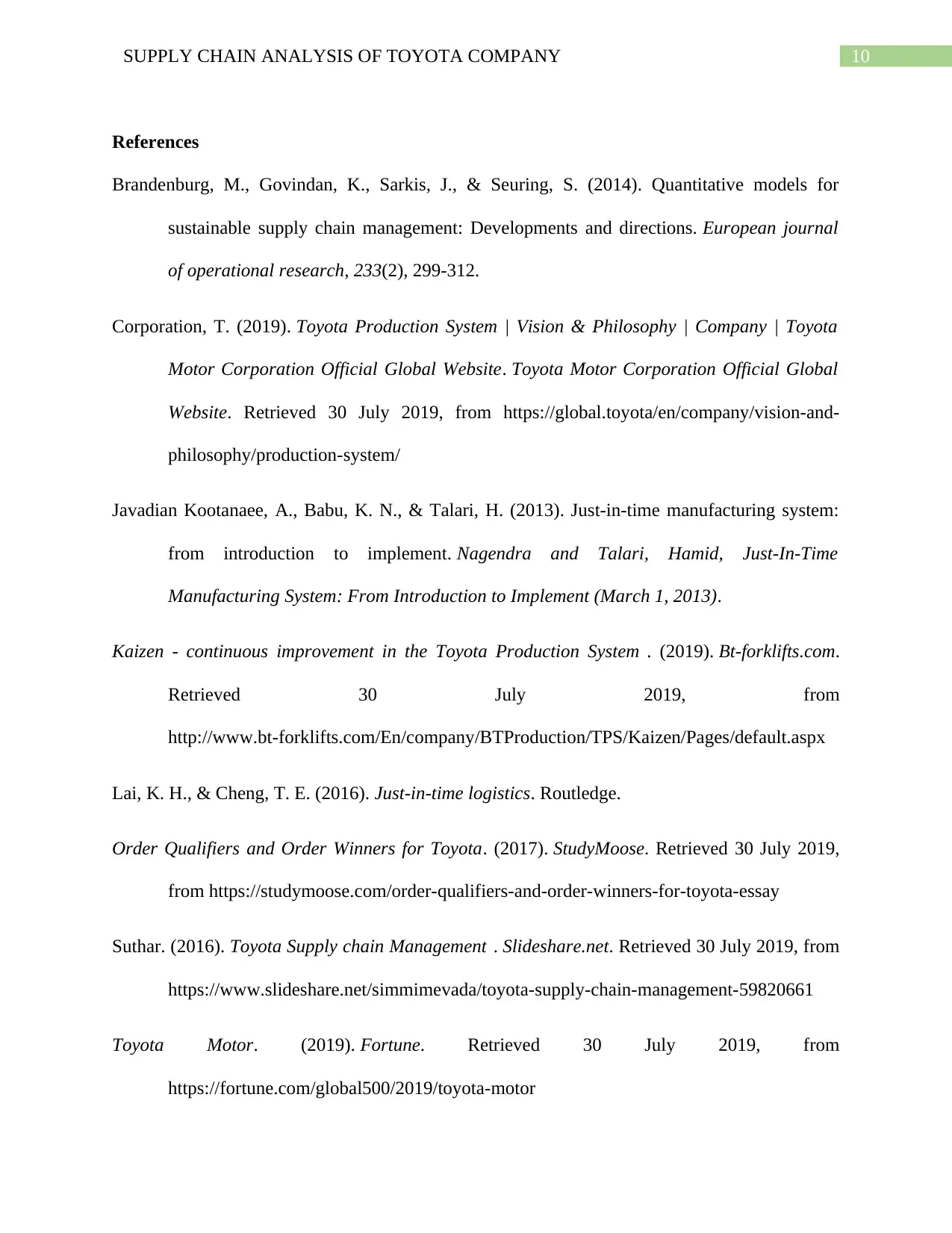
10SUPPLY CHAIN ANALYSIS OF TOYOTA COMPANY
References
Brandenburg, M., Govindan, K., Sarkis, J., & Seuring, S. (2014). Quantitative models for
sustainable supply chain management: Developments and directions. European journal
of operational research, 233(2), 299-312.
Corporation, T. (2019). Toyota Production System | Vision & Philosophy | Company | Toyota
Motor Corporation Official Global Website. Toyota Motor Corporation Official Global
Website. Retrieved 30 July 2019, from https://global.toyota/en/company/vision-and-
philosophy/production-system/
Javadian Kootanaee, A., Babu, K. N., & Talari, H. (2013). Just-in-time manufacturing system:
from introduction to implement. Nagendra and Talari, Hamid, Just-In-Time
Manufacturing System: From Introduction to Implement (March 1, 2013).
Kaizen - continuous improvement in the Toyota Production System . (2019). Bt-forklifts.com.
Retrieved 30 July 2019, from
http://www.bt-forklifts.com/En/company/BTProduction/TPS/Kaizen/Pages/default.aspx
Lai, K. H., & Cheng, T. E. (2016). Just-in-time logistics. Routledge.
Order Qualifiers and Order Winners for Toyota. (2017). StudyMoose. Retrieved 30 July 2019,
from https://studymoose.com/order-qualifiers-and-order-winners-for-toyota-essay
Suthar. (2016). Toyota Supply chain Management . Slideshare.net. Retrieved 30 July 2019, from
https://www.slideshare.net/simmimevada/toyota-supply-chain-management-59820661
Toyota Motor. (2019). Fortune. Retrieved 30 July 2019, from
https://fortune.com/global500/2019/toyota-motor
References
Brandenburg, M., Govindan, K., Sarkis, J., & Seuring, S. (2014). Quantitative models for
sustainable supply chain management: Developments and directions. European journal
of operational research, 233(2), 299-312.
Corporation, T. (2019). Toyota Production System | Vision & Philosophy | Company | Toyota
Motor Corporation Official Global Website. Toyota Motor Corporation Official Global
Website. Retrieved 30 July 2019, from https://global.toyota/en/company/vision-and-
philosophy/production-system/
Javadian Kootanaee, A., Babu, K. N., & Talari, H. (2013). Just-in-time manufacturing system:
from introduction to implement. Nagendra and Talari, Hamid, Just-In-Time
Manufacturing System: From Introduction to Implement (March 1, 2013).
Kaizen - continuous improvement in the Toyota Production System . (2019). Bt-forklifts.com.
Retrieved 30 July 2019, from
http://www.bt-forklifts.com/En/company/BTProduction/TPS/Kaizen/Pages/default.aspx
Lai, K. H., & Cheng, T. E. (2016). Just-in-time logistics. Routledge.
Order Qualifiers and Order Winners for Toyota. (2017). StudyMoose. Retrieved 30 July 2019,
from https://studymoose.com/order-qualifiers-and-order-winners-for-toyota-essay
Suthar. (2016). Toyota Supply chain Management . Slideshare.net. Retrieved 30 July 2019, from
https://www.slideshare.net/simmimevada/toyota-supply-chain-management-59820661
Toyota Motor. (2019). Fortune. Retrieved 30 July 2019, from
https://fortune.com/global500/2019/toyota-motor
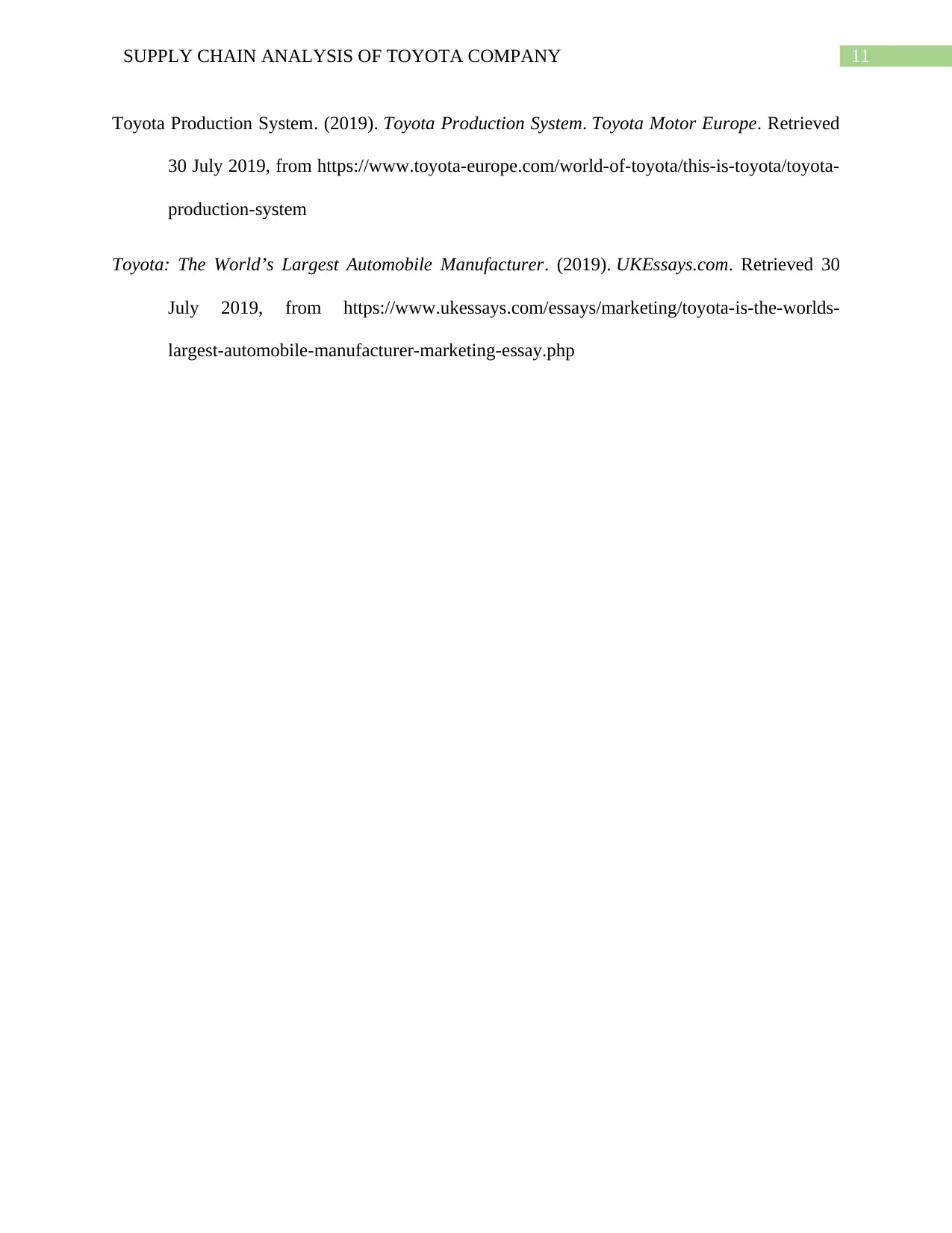
11SUPPLY CHAIN ANALYSIS OF TOYOTA COMPANY
Toyota Production System. (2019). Toyota Production System. Toyota Motor Europe. Retrieved
30 July 2019, from https://www.toyota-europe.com/world-of-toyota/this-is-toyota/toyota-
production-system
Toyota: The World’s Largest Automobile Manufacturer. (2019). UKEssays.com. Retrieved 30
July 2019, from https://www.ukessays.com/essays/marketing/toyota-is-the-worlds-
largest-automobile-manufacturer-marketing-essay.php
Toyota Production System. (2019). Toyota Production System. Toyota Motor Europe. Retrieved
30 July 2019, from https://www.toyota-europe.com/world-of-toyota/this-is-toyota/toyota-
production-system
Toyota: The World’s Largest Automobile Manufacturer. (2019). UKEssays.com. Retrieved 30
July 2019, from https://www.ukessays.com/essays/marketing/toyota-is-the-worlds-
largest-automobile-manufacturer-marketing-essay.php
⊘ This is a preview!⊘
Do you want full access?
Subscribe today to unlock all pages.

Trusted by 1+ million students worldwide
1 out of 12
Related Documents
Your All-in-One AI-Powered Toolkit for Academic Success.
+13062052269
info@desklib.com
Available 24*7 on WhatsApp / Email
![[object Object]](/_next/static/media/star-bottom.7253800d.svg)
Unlock your academic potential
Copyright © 2020–2025 A2Z Services. All Rights Reserved. Developed and managed by ZUCOL.




